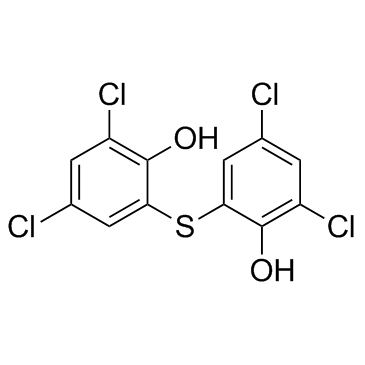Bithionol

Bithionol structure
|
Common Name | Bithionol | ||
|---|---|---|---|---|
| CAS Number | 97-18-7 | Molecular Weight | 356.052 | |
| Density | 1.8±0.1 g/cm3 | Boiling Point | 444.7±45.0 °C at 760 mmHg | |
| Molecular Formula | C12H6Cl4O2S | Melting Point | 188°C | |
| MSDS | Chinese USA | Flash Point | 222.8±28.7 °C | |
| Symbol |

GHS07 |
Signal Word | Warning | |
|
An improved thyroid hormone reporter assay to determine the thyroid hormone-like activity of amiodarone, bithionol, closantel and rafoxanide.
Toxicol. Lett. 208(1) , 30-5, (2012) A number of environmental chemicals have been reported to exhibit thyroid hormone-like activity. Since thyroid hormones play a crucial role in development, it is important to identify chemicals in the environment that are capable of endocrine disruption of th... |
|
|
Determination of bithionol, bromophen, nitroxynil, oxyclozanide, and tribromsalan in milk with liquid chromatography coupled with tandem mass spectrometry.
J. AOAC Int. 93(4) , 1340-6, (2010) LC/MS/MS was developed to determine the residues of bithionol (BTN), bromofen (BMF), nitroxynil (NTX), oxyclozanide (OCZ), and tribromsalan (TBS) in milk. Samples were extracted with ethyl acetate and cleaned up by liquid-liquid separation with acetonitrile a... |
|
|
Novel therapeutic strategy for neurodegeneration by blocking Aβ seeding mediated aggregation in models of Alzheimer's disease.
Neurobiol. Dis. 74 , 144-57, (2015) Aβ accumulation plays a central role in the pathogenesis of Alzheimer's disease (AD). Recent studies suggest that the process of Aβ nucleated polymerization is essential for Aβ fibril formation, pathology spreading and toxicity. Therefore, targeting this proc... |
|
|
Bithionol inhibits ovarian cancer cell growth in vitro - studies on mechanism(s) of action.
BMC Cancer 14 , 61, (2014) Drug resistance is a cause of ovarian cancer recurrence and low overall survival rates. There is a need for more effective treatment approaches because the development of new drug is expensive and time consuming. Alternatively, the concept of 'drug repurposin... |
|
|
Slack, Slick and Sodium-Activated Potassium Channels.
ISRN Neurosci. 2013(2013) , (2013) The Slack and Slick genes encode potassium channels that are very widely expressed in the central nervous system. These channels are activated by elevations in intracellular sodium, such as those that occur during trains of one or more action potentials, or f... |
|
|
Hydrogen peroxide induced stress in human keratinocytes and its effect on bithionol toxicity.
Toxicol. In Vitro 15(4-5) , 441-5, (2001) Exposure to hydrogen peroxide causes oxidative stress in keratinocytes. Previous work has shown that the antiparasitic drug bithionol has an EC(50) of 0.7 microg/ml (2 microM) with primary human keratinocytes, but that these cells do not respond to photoactiv... |
|
|
Further development of bithionol therapy as a treatment for amoebic gill disease in Atlantic salmon, Salmo salar L.
J. Fish Dis. 32(5) , 391-400, (2009) This study examined the efficacy of bithionol as a prophylactic or therapeutic oral treatment for Atlantic salmon (AS), Salmo salar, affected by amoebic gill disease (AGD). Furthermore, it explored the interaction of bithionol oral therapy with the current st... |
|
|
Fasciola hepatica infestation as a very rare cause of extrahepatic cholestasis.
World J. Gastroenterol. 10(20) , 3076-7, (2004) Fasciola hepatica, an endemic parasite in Turkey, is still a very rare cause of cholestasis worldwide. Through ingestion of contaminated water plants like watercress, humans can become the definitive host of this parasite. Cholestatic symptoms may be sudden b... |
|
|
Molecular cloning, expression and characterization of a novel mouse SULT6 cytosolic sulfotransferase.
J. Biochem. 146(3) , 399-405, (2009) By searching the mouse EST database, we identified a novel mouse cytosolic sulfotransferase (SULT) cDNA (RIKEN cDNA 2410078J06). Sequence analysis revealed that this new SULT belongs to the cytosolic SULT6 gene family. The recombinant form of this newly ident... |
|
|
Indirect evidence of ectopic pancreatic fascioliasis in a human.
J. Gastroenterol. Hepatol. 21(10) , 1631-3, (2006) Fascioliasis is not common in humans and, furthermore, its ectopic migration into the pancreas is extremely rare. A definitive diagnosis of ectopic fascioliasis is based on the demonstration of flukes in the affected organ. If the flukes invade the parenchyma... |